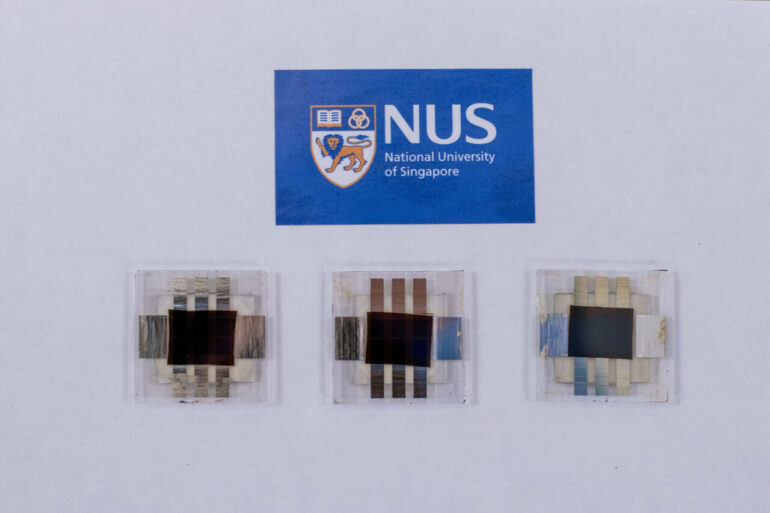A team of researchers from the National University of Singapore (NUS) has set a new record in the power conversion efficiency of solar cells made using perovskite and organic materials. This technological breakthrough paves the way for flexible, light-weight, low cost and ultra-thin photovoltaic cells which are ideal for powering vehicles, boats, blinds and other applications.
“Technologies for clean and renewable energy are extremely important for carbon reduction. Solar cells that directly convert solar energy into electricity are among the most promising clean energy technologies. High power conversion efficiency of solar cells is critical for generating more electrical power using a limited area and this, in turn, reduces the total cost of generating solar energy,” explained lead researcher Presidential Young Professor Hou Yi, who is from the NUS Department of Chemical and Biomolecular Engineering and also leading a “Perovskite-based Multi-junction Solar Cells group” at the Solar Energy Research Institute of Singapore at NUS.
“The main motivation of this study is to improve the power conversion efficiency of perovskite/organic tandem solar cells. In our latest work, we have demonstrated a power conversion efficiency of 23.6%—this is the best performance for this type of solar cells to date,” added Dr. Chen Wei, Research Fellow at the NUS Department of Chemical and Biomolecular Engineering and the first author of this work.
This achievement is significant leap from the current power conversion rate of about 20% reported by other studies on perovskite/organic tandem solar cells, and is approaching the power conversion rate of 26.7% of silicon solar cells, which is the dominating solar technology in the current solar photovoltaic (PV) market.
This innovation was published in Nature Energy on 20 January 2022. The research was conducted in collaboration with scientists from the University of Hong Kong and Southern University of Science and Technology.
New trends in the solar world
Solar cell technology has achieved tremendous growth in recent years as a sustainable energy source.The reliability, efficiency, durability, and price of solar cells have a crucial impact on the commercial potential and large-scale implementation of solar energy projects around the world.
The conventional solar cellsbeing used in solarpower plants are based on a single-junction architecture. The practical power conversion efficiency of single-junction solar cells is limited to about 27% in industrial production. To push the frontiers of solar energy production will require novel solutions for solar cells to perform better in power conversion.
In order to raise the power conversion efficiency of solar cells to go beyond 30%, stacks of two or more absorber layers (multi-junction cells) are required. Tandem solar cells, which are made using two different types of photovoltaic materials, is a hot area of research.
In their latest project, Assistant Professor Hou and his team break new ground in the field of perovskite/organic tandem solar cells. Their discovery opens the door to thin-film tandem solar cells that are light and bendable, which could have wide-ranging applications.
Breakthrough in power conversion efficiency
A tandem solar cell comprises two or more subcells electrically connected using interconnecting layers (ICLs). The ICL plays a critical role in determining the performance and reproducibility of a device. An effective ICL should be chemically inert, electrically conductive and optically transparent.
Although perovskite/organic tandem solar cells are attractive for next-generation thin-film photovoltaics, their efficiency lags behind other types of tandem solar cells. To address this technological challenge, Asst Prof Hou and his team developed a novel and effective ICL that reduces voltage, optical and electrical losses within the tandem solar cell. This innovation significantly improves the efficiency of theperovskite/organic tandem solar cells, achieving a power conversion rate of 23.6%.
“Our study shows the great potential of perovskite-based tandem solar cells for future commercial application of photovoltaic technology. Building on our new discovery, we hope to further improve the performance of our tandem solar cells and scale up this technology,” said Asst Prof Hou.
More information:
Wei Chen et al, Monolithic perovskite/organic tandem solar cells with 23.6% efficiency enabled by reduced voltage losses and optimized interconnecting layer, Nature Energy (2022). DOI: 10.1038/s41560-021-00966-8
Provided by
National University of Singapore
Citation:
Research team sets new efficiency record for solar cell technology (2022, January 21)


